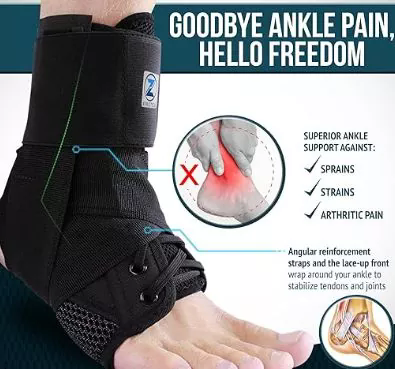Sprained Ankle Brace Support: A Comprehensive Guide to Recovery and Support
2025-05-07
Ankle sprains are one of the most common injuries, especially in sports and physical activities. They can range from mild to severe and often result in pain, swelling, and difficulty walking. One effective way to aid in the recovery process and reduce the risk of further injury is by using a sprained ankle brace support. In this article, we’ll explore the benefits, types, and proper usage of ankle braces, as well as tips for managing a sprained ankle.

What Is a Sprained Ankle?
A sprained ankle occurs when the ligaments surrounding the ankle joint are stretched or torn due to an external force, such as twisting the ankle in an awkward direction. The severity of the sprain is typically categorized into three grades:
Grade 1 (Mild): The ligaments are stretched but not torn. There may be mild swelling and pain.
Grade 2 (Moderate): The ligaments are partially torn, leading to moderate swelling, bruising, and pain.
Grade 3 (Severe): The ligaments are completely torn, and there is significant swelling, bruising, and a loss of function in the ankle joint.
Ankle sprains can occur during physical activities like running, hiking, or playing sports, but they can also happen during everyday activities such as walking on uneven surfaces or stepping off a curb.
The Role of a Sprained Ankle Brace Support
A sprained ankle brace is designed to provide stability and support to the injured ankle, helping to alleviate pain and prevent further damage. The primary purpose of using a brace is to limit the range of motion of the ankle joint, which reduces the risk of reinjury while promoting the healing of the ligaments.
Here are some key ways a sprained ankle brace support helps in recovery:
1. Stabilization: The brace holds the ankle in a stable position, which helps prevent further twisting or turning of the ankle. This minimizes the risk of re-injuring the ligaments.
2. Pain Relief: By offering compression and support, the brace can help reduce swelling and alleviate the pain that comes with an ankle sprain.
3. Increased Confidence: Wearing a brace provides psychological support, as it allows individuals to feel more confident when walking or engaging in light physical activity.
4. Prevention of Overuse: The brace can also protect the ankle from overuse during recovery, allowing for a more gradual return to normal activity levels.
5. Enhanced Recovery: By limiting movement and providing compression, a sprained ankle brace can accelerate the healing process and help avoid complications like chronic instability.
Types of Sprained Ankle Braces
When choosing a sprained ankle brace, there are different types depending on the severity of the sprain, the level of support needed, and personal preferences. Here are the most common types:
1. Elastic Bandage Braces: These are simple, lightweight braces that wrap around the ankle and provide mild compression and support. They are most suitable for mild sprains (Grade 1). They are affordable and easy to apply but may not provide enough support for more severe sprains.
2. Lace-up Braces: Lace-up ankle braces provide more controlled compression and offer moderate support for moderate sprains (Grade 2). They are designed to mimic the support you’d get from taping the ankle, but with the added convenience of being reusable.
3. Rigid Braces: These braces offer the most support and are ideal for severe sprains (Grade 3). Rigid braces have hard plastic or metal components that provide stabilization and prevent the ankle from moving inappropriately. They are typically used for more severe sprains or during the initial stages of recovery when the ankle is still fragile.
4. Aircast Braces: An Aircast brace is an inflatable brace that provides both compression and support. It features air cells that can be inflated to customize the level of pressure applied to the ankle. This type of brace is ideal for those who need to manage swelling while maintaining mobility.
5. Ankle Sleeves: These are soft, lightweight, and stretchable braces made from materials like neoprene. They offer mild compression and warmth to the injured area, promoting circulation and reducing swelling. These are best for mild sprains or as a preventive measure.
How to Choose the Right Ankle Brace
Choosing the right ankle brace depends on the severity of the sprain and the activity level of the individual. Here are some factors to consider when selecting a brace:
1. Severity of the Injury: For mild sprains, an elastic bandage or ankle sleeve might suffice. However, for moderate or severe sprains, more rigid or lace-up braces are recommended for additional stability.
2. Comfort: It’s essential to choose a brace that fits well and is comfortable for long periods of wear. Look for braces with adjustable straps or those made from breathable materials to prevent overheating and discomfort.
3. Mobility Needs: Consider the level of mobility required. If you need to walk or resume light physical activity during recovery, a lace-up or aircast brace may be more suitable. For complete immobilization, a rigid brace is best.
4. Duration of Use: If you’re in the recovery phase, you may need a brace that can be worn for extended periods. Look for models that are durable, easy to put on and remove, and supportive enough to protect the injured area during daily activities.
How to Properly Use a Sprained Ankle Brace
To get the most benefit from your sprained ankle brace, it's important to wear it correctly. Here are some tips for proper use:
1. Wear it Consistently: In the early stages of recovery, wear your brace consistently, even when resting. This will help keep the ankle stable and prevent unnecessary movements that could aggravate the injury.
2. Adjust for Comfort: Ensure that the brace is snug but not too tight. It should provide support without cutting off circulation. If your brace is too tight, it may cause more harm than good.
3. Follow Professional Advice: Consult with a healthcare professional about the most appropriate type of brace and the duration of use. They can guide you through your recovery and recommend any additional treatments.
4. Combine with R.I.C.E. Method: In addition to using the ankle brace, follow the R.I.C.E. (Rest, Ice, Compression, Elevation) method to manage swelling and promote healing.
Conclusion
A sprained ankle brace is an invaluable tool in the recovery process for anyone who has sustained an ankle injury. Whether you have a mild sprain or a more severe injury, wearing the right brace can provide much-needed stability, support, and pain relief. With the proper care and use, a sprained ankle brace can significantly speed up recovery and help prevent future injuries. Always remember to consult with a healthcare professional for personalized advice on the best treatment and rehabilitation plan for your specific injury.


